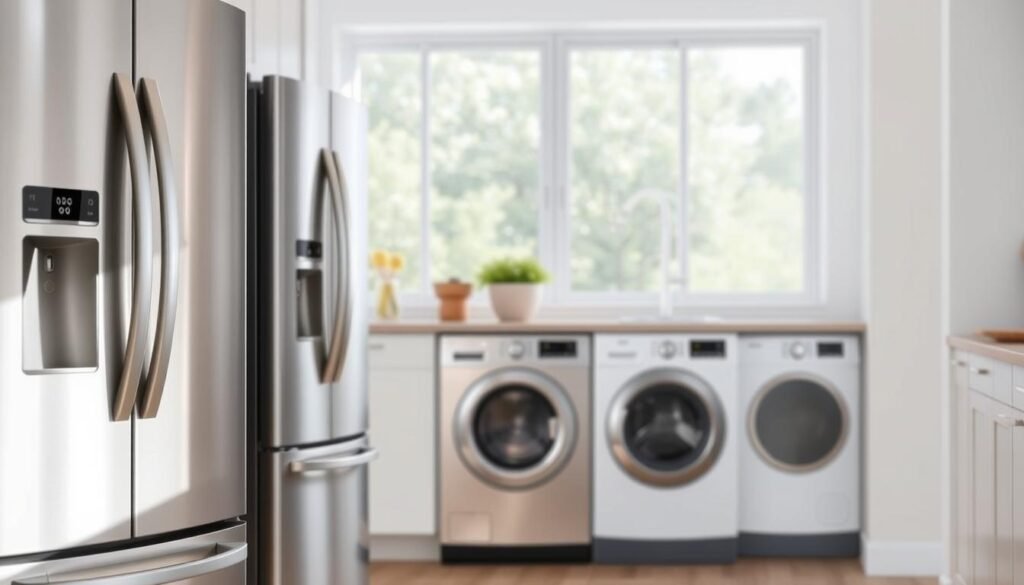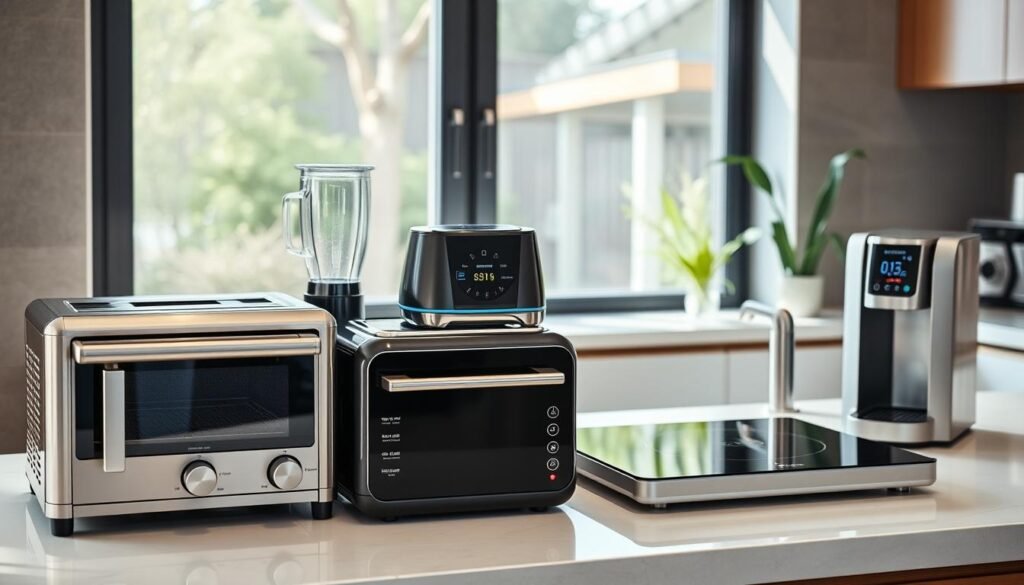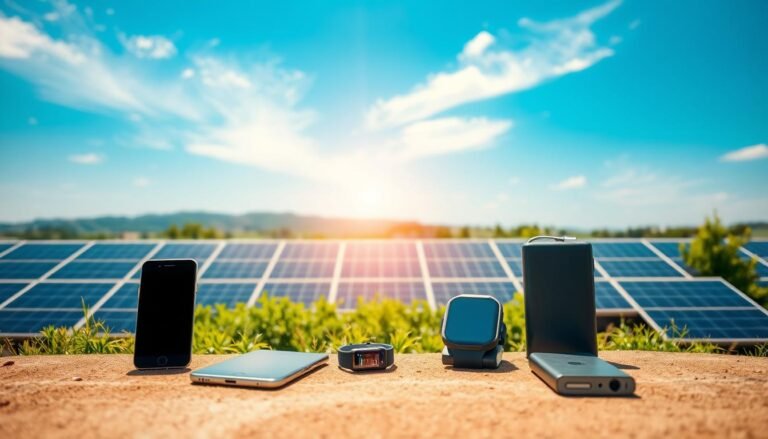As we move into 2025, Australian homeowners are becoming increasingly aware of the importance of reducing their energy consumption. Not only can it help save money on utility bills, but it also lessens the environmental impact.
Choosing green appliances is a significant step towards a more sustainable lifestyle. These appliances are designed to use less energy while maintaining performance, making them an attractive option for families looking to reduce their carbon footprint.
By investing in energy-efficient solutions, families can enjoy cost savings and contribute to a cleaner environment. It’s a practical way to make a positive impact without compromising on comfort or convenience.
Key Takeaways
- Green appliances can significantly reduce energy consumption.
- Energy-efficient solutions offer cost savings on utility bills.
- Investing in sustainable appliances contributes to a cleaner environment.
- Australian families can benefit from reduced energy bills and a lower carbon footprint.
- Choosing energy-efficient appliances is a practical step towards sustainability.
The Dual Benefits of Energy Efficiency
Energy efficiency is a win-win for Australian households, offering financial savings and environmental benefits. By adopting energy-efficient appliances, families can significantly reduce their utility bills while contributing to a more sustainable environment.
Financial Savings for Australian Households
Switching to energy-efficient appliances can lead to substantial financial savings. These savings are realized through reduced energy consumption, which directly impacts household utility bills.
Average Utility Bill Reductions
On average, households that adopt energy-efficient appliances can see a reduction of up to 30% in their utility bills. This is a significant saving that can be redirected towards other household needs.
Long-term Return on Investment
While the initial cost of energy-efficient appliances may be higher, they offer a long-term return on investment through the savings made on utility bills. This makes them a financially savvy choice for households.
Environmental Impact Reduction
Energy-efficient appliances not only save money but also play a crucial role in reducing environmental impact. By consuming less energy, these appliances help decrease the overall carbon footprint of households.
Carbon Footprint Decrease
The use of energy-efficient appliances leads to a decrease in carbon emissions, contributing to a cleaner environment. This is a significant step towards achieving a more sustainable future.
Resource Conservation Benefits
By reducing energy consumption, households also contribute to the conservation of natural resources. This is an essential aspect of maintaining ecological balance and ensuring a sustainable future for coming generations.
By making the switch to energy-efficient appliances, Australian households can enjoy both financial savings and contribute to environmental sustainability. It’s a simple yet effective way to make a positive impact.
Understanding Energy Ratings in Australia
In Australia, energy ratings play a pivotal role in helping households make informed decisions about energy-efficient appliances. The energy rating system is designed to provide clear information about the energy efficiency of various appliances, enabling consumers to compare and choose products that offer the best energy savings.
The Energy Rating Label Explained
The Energy Rating Label is a crucial tool for consumers. It provides an at-a-glance comparison of the energy efficiency of similar products.
Mandatory Labelling Requirements
In Australia, the federal government requires most major appliances to display an ENERGY GUIDE label, which provides estimated yearly operating costs and energy consumption. This mandatory labelling helps consumers understand the potential energy savings of different models.
How to Read the Label Correctly
To read the label correctly, look for the star rating and the energy consumption information. The star rating gives a quick comparison of energy efficiency, while the energy consumption data provides a more detailed insight into the appliance’s energy usage.
Star Ratings and What They Mean
Star ratings are a key component of the energy rating system. They provide a simple way to compare the energy efficiency of different appliances.
Differences Between 6-Star and 10-Star Systems
Australia uses a star rating system that ranges, with higher ratings indicating better energy efficiency. Understanding the differences between various star ratings helps consumers make informed choices.
MEPS (Minimum Energy Performance Standards)
MEPS are regulations that set the minimum energy performance standards for appliances. These standards ensure that all appliances sold in Australia meet a certain level of energy efficiency.
Australian Regulatory Framework
The Australian government has established a regulatory framework to enforce MEPS and ensure compliance across the appliance industry. This framework is crucial for maintaining high energy efficiency standards in the market.
By understanding energy ratings, Australian consumers can make more informed decisions when purchasing appliances, leading to significant energy savings and a reduced environmental impact.
Energy-Efficient Appliances for Families: A Comprehensive Guide
Understanding what makes an appliance energy-efficient is key to making informed purchasing decisions. Energy-efficient appliances consume less energy while delivering the same or better performance than their less-efficient counterparts.
What Makes an Appliance Energy-Efficient?
Several factors contribute to an appliance’s energy efficiency. Technology innovations play a significant role, with advancements like inverter technology in air conditioners and refrigerators significantly reducing energy consumption.
Technology Innovations
Innovations such as smart sensors and IoT connectivity enable appliances to operate more efficiently. For instance, a smart thermostat can learn your schedule and preferences to optimize heating and cooling.
Material and Design Considerations
The materials used and the design of an appliance also impact its energy efficiency. For example, appliances with better insulation require less energy to maintain the desired temperature.

Long-term Benefits for Family Budgets
Investing in energy-efficient appliances can lead to significant savings on energy bills over time. Calculating your potential savings involves considering the appliance’s energy consumption and your household’s usage patterns.
Calculating Your Potential Savings
To estimate savings, compare the energy consumption of your current appliance with that of a more efficient model. You can use online tools or consult with a professional to get an accurate estimate.
Balancing Initial Cost with Lifetime Savings
While energy-efficient appliances often have a higher upfront cost, they can offer substantial long-term savings. It’s essential to consider when to upgrade your existing appliances to maximize these benefits.
When to Upgrade Existing Appliances
Upgrade your appliances when they are nearing the end of their lifespan or when you notice a significant increase in energy bills. Planning your upgrades strategically can help you save even more.
Energy-Efficient Refrigerators and Freezers
For Australian families looking to cut down on their energy bills, energy-efficient refrigerators and freezers are a great place to start. These appliances are not only crucial for daily life, but upgrading to energy-efficient models can also lead to significant savings over time.
Top Energy-Saving Models Available in Australia
Australia’s market offers a variety of energy-efficient refrigerators and freezers from renowned brands. Some of the top models feature advanced technologies that minimize energy consumption without compromising on performance.
Fisher & Paykel Energy-Smart Options
Fisher & Paykel’s range includes models equipped with inverter technology, which adjusts energy usage based on the contents and temperature settings. This results in less energy waste and lower utility bills.
LG and Samsung Eco-Models
LG and Samsung also offer eco-friendly options with features like smart technologies that optimize energy consumption. For instance, some models come with Wi-Fi connectivity, allowing users to monitor and adjust settings remotely through a smartphone app. You can explore more energy-efficient refrigerators on Energy Star.
Features That Reduce Power Consumption
Several features contribute to the energy efficiency of modern refrigerators and freezers. Understanding these can help consumers make informed decisions.
Inverter Technology Explained
Inverter compressors are a key feature in many energy-efficient models. They work by adjusting their speed to maintain the optimal temperature, rather than constantly switching on and off. This not only reduces energy consumption but also helps in maintaining a consistent temperature, which is better for food preservation.
Insulation and Sealing Innovations
Advanced insulation materials and sealing technologies also play a crucial role in minimizing energy loss. These innovations help maintain the internal temperature of the refrigerator or freezer, reducing the need for the compressor to work harder than necessary.
Optimal Sizing for Family Needs
Choosing the right size of refrigerator or freezer for your family’s needs is essential to avoid energy waste.
Right-Sizing to Avoid Energy Waste
A unit that is too large will consume more energy than necessary, while one that is too small may not effectively store your food, leading to waste. Assessing your family’s needs and selecting a model that closely matches those needs is crucial for optimal energy efficiency.
Eco-Friendly Washing Machines and Dryers
Eco-friendly washing machines and dryers are becoming the norm for families looking to save energy and water. As Australians become more environmentally conscious, the demand for energy-efficient laundry appliances has increased.
Water-Saving Front Loaders vs Top Loaders
Front-loading washers are typically more efficient than top-load models, using less water and energy. Front-loaders use a horizontal axis to rotate clothes, which reduces water consumption. In contrast, top-loaders use more water and energy due to their vertical axis design.
Australian Water Efficiency Labelling
Australian regulations require washing machines to be labelled with their water efficiency ratings. Look for the WELS label when purchasing a washing machine to ensure you’re getting a water-efficient model.
Best Models for Large Families
For large families, it’s essential to choose a washing machine with a high capacity and efficient water usage. Some top-rated models include those with advanced sensors that detect load size and adjust water usage accordingly.
Heat Pump Dryer Technology
Heat pump dryers are a game-changer for energy efficiency. They work by reusing the hot air from the drying process, significantly reducing energy consumption.
How They Cut Energy Use by 50%
By reusing hot air, heat pump dryers can cut energy use by up to 50% compared to traditional dryers. This not only saves energy but also reduces your electricity bills.
Cold Water Washing Techniques
Washing clothes in cold water is another effective way to reduce energy consumption. Most modern detergents are designed to work well in cold water.
Detergents for Energy-Efficient Cycles
Using the right detergent can enhance the efficiency of your washing machine. Look for detergents specifically designed for cold water washing to maximize energy savings.
Energy-Efficient Dishwashers
The quest for a more sustainable home often leads to the kitchen, where energy-efficient dishwashers play a crucial role. Modern dishwashers have evolved to not only clean dishes effectively but also to save water and energy, making them an essential appliance for eco-conscious families.
Water and Energy Consumption Comparisons
One of the primary benefits of energy-efficient dishwashers is their ability to reduce water and energy consumption compared to traditional hand washing or older dishwasher models. Studies have shown that modern energy-efficient dishwashers use significantly less water and energy per cycle.
Hand Washing vs Machine Efficiency
When comparing hand washing to using a dishwasher, the latter often comes out on top in terms of efficiency, especially when fully loaded. Energy-efficient dishwashers are designed to use less water and heat it to a higher temperature, ensuring dishes are cleaned and sanitized effectively.
Eco Cycles and Their Effectiveness
Most energy-efficient dishwashers come equipped with eco cycles designed to minimize energy and water usage. These cycles are perfect for loads that are not heavily soiled, offering a balance between cleaning performance and energy efficiency.
Temperature and Duration Settings
The ability to adjust temperature and duration settings allows users to customize their wash cycles according to their needs. Lower temperatures and shorter cycles can significantly reduce energy consumption, although they may not be suitable for all types of dishes.
Family-Sized Models with High Efficiency
For larger families, it’s essential to choose a dishwasher that can handle a substantial load while maintaining high efficiency. Brands like Bosch and Miele offer family-sized models with advanced features that ensure dishes are cleaned effectively while minimizing energy and water usage.
Bosch and Miele Eco Options
Bosch and Miele are renowned for their eco-friendly dishwasher models. Bosch’s EcoSilence Drive and Miele’s EcoFeedback features are designed to reduce energy consumption and provide users with detailed information on their washing habits, helping them optimize their usage.
By choosing an energy-efficient dishwasher, families can enjoy cleaner dishes while contributing to a more sustainable future. With various models available in the market, it’s crucial to compare features and efficiency ratings to find the best fit for your household needs.
Green Cooking Appliances That Save Energy
In the pursuit of a more sustainable lifestyle, Australians are increasingly opting for green cooking appliances that not only save energy but also enhance their cooking experience. “The future of cooking is not just about the food; it’s about how we cook it,” says an energy efficiency expert. This shift towards eco-friendly cooking solutions is driven by the desire to reduce energy consumption and lower utility bills.
Induction vs Gas vs Electric Cooktops
The choice between induction, gas, and electric cooktops is crucial in determining energy efficiency in the kitchen. Induction cooktops stand out for their energy-saving capabilities, as they directly heat the cookware, reducing energy loss.
Energy Transfer Efficiency Comparison
- Induction cooktops: Up to 90% energy transfer efficiency
- Gas cooktops: Approximately 40-50% energy transfer efficiency
- Electric cooktops: Around 50-60% energy transfer efficiency
As evident from the comparison, induction cooking is the most energy-efficient method, making it an attractive option for eco-conscious consumers.
Energy-Efficient Ovens and Microwaves
Ovens and microwaves are staples in every Australian kitchen. Opting for energy-efficient models can significantly reduce energy consumption.
Fan-Forced vs Conventional Heating
Fan-forced ovens are more energy-efficient than conventional ovens as they distribute heat more evenly, allowing for lower temperature settings and reduced cooking times. This results in significant energy savings over time.
Smart Cooking Technologies
The integration of smart technologies into cooking appliances has revolutionized the way we cook, making it more energy-efficient. Smart cooking appliances can optimize energy usage by automatically adjusting cooking times and temperatures.
Australian-Compatible Smart Features
When selecting smart cooking appliances, it’s essential to ensure they are compatible with Australian standards and power requirements. Features such as remote monitoring and automated cooking schedules not only enhance convenience but also contribute to energy savings.
By embracing green cooking appliances and smart cooking technologies, Australian households can significantly reduce their energy consumption, contributing to a more sustainable future.
Efficient Heating and Cooling Solutions for Australian Climates
Efficient heating and cooling are crucial for Australian homes, given the country’s varied and often extreme weather conditions. As temperatures fluctuate, the right heating and cooling systems can significantly reduce energy consumption and enhance comfort.
Energy-Efficient Air Conditioners
Energy-efficient air conditioners are a vital component of home climate control in Australia. These systems not only provide comfort but also help in reducing energy bills.
Inverter Technology Benefits
Inverter technology in air conditioners adjusts the compressor speed to maintain the desired temperature, reducing energy consumption. This technology can lead to significant savings on energy bills.
Sizing for Different Climate Zones
Proper sizing of air conditioners is essential for different climate zones. An oversized or undersized system can lead to inefficiency and increased energy costs.
| Climate Zone | Recommended Air Conditioner Size | Energy Efficiency Rating |
|---|---|---|
| Tropical | Large Capacity | High (Above 5 Stars) |
| Temperate | Medium Capacity | Medium to High (4-5 Stars) |
| Cold | High Heating Capacity | High (Above 5 Stars) |
Heat Pumps and Their Benefits
Heat pumps are another efficient solution for heating and cooling. They work by transferring heat from one location to another, providing both heating and cooling.
Suitability for Australian Weather Patterns
Heat pumps are suitable for various Australian weather patterns. They are particularly effective in temperate climates where temperatures do not frequently drop below zero.
Smart Thermostats and Zoning Systems
Smart thermostats and zoning systems optimize heating and cooling by ensuring that energy is not wasted on unoccupied areas of the home.
Adapting to Seasonal Changes
These systems can be programmed to adjust to seasonal changes, ensuring optimal comfort and efficiency throughout the year.
By investing in energy-efficient heating and cooling solutions, Australian households can enjoy a more comfortable living environment while reducing their energy consumption and bills.
Small Appliances with Big Energy Savings
Energy-efficient small appliances are a simple yet effective way to cut down on household energy usage. These appliances, often overlooked in discussions about energy efficiency, can collectively make a significant difference in your energy bills.
Energy-Efficient Kettles and Coffee Makers
Kettles and coffee makers are among the most frequently used small appliances in Australian households. Opting for energy-efficient models can lead to noticeable savings. Insulated models, for instance, retain heat longer, reducing the need for constant reheating.
Insulated vs Standard Models
Insulated kettles and coffee makers use less energy compared to standard models. For example, an insulated kettle can keep water warm for an extended period, thus reducing the energy required for reheating.
| Appliance Type | Energy Consumption (Average) | Annual Savings with Energy-Efficient Model |
|---|---|---|
| Kettle (Standard) | 1.5 kWh per day | $20-$30 |
| Kettle (Insulated) | 1.0 kWh per day | |
| Coffee Maker (Standard) | 0.8 kWh per day | $15-$25 |
| Coffee Maker (Energy-Efficient) | 0.5 kWh per day |
Low-Power Toasters and Blenders
Toasters and blenders are other common small appliances that can be optimized for energy efficiency. Low-power models are designed to consume less energy without compromising performance.
Wattage Considerations
When selecting a toaster or blender, consider the wattage. Lower wattage appliances consume less energy. For instance, a 800-watt toaster is more energy-efficient than a 1200-watt model.

Eco-Friendly Food Processors
Eco-friendly food processors are designed to be energy-efficient while offering multiple functions, reducing the need for multiple appliances.
Multi-Function to Reduce Appliance Count
Multi-function food processors can perform various tasks such as chopping, slicing, and pureeing. By consolidating functions into a single appliance, you can reduce overall energy consumption.
Smart Home Integration for Maximum Efficiency
The future of energy efficiency lies in smart home integration, a game-changer for Australian households. By seamlessly connecting various appliances and systems, smart home technology enables homeowners to optimize their energy usage, reduce waste, and save on utility bills.
Connecting Appliances to Home Energy Management
One of the key benefits of smart home integration is the ability to connect appliances to a central home energy management system. This allows for real-time monitoring and control of energy consumption, making it easier to identify areas of inefficiency.
Compatible Systems for Australian Homes
Australian homeowners can choose from a variety of compatible smart home systems, including those offered by major energy providers. These systems are designed to work with a range of appliances, ensuring that homeowners can integrate their existing devices into the smart network.
Automated Scheduling for Off-Peak Usage
Smart home integration also enables automated scheduling, allowing homeowners to run their appliances during off-peak hours when energy rates are lower. This not only saves money but also helps to reduce peak demand on the grid.
Working with Australian Energy Providers
Many Australian energy providers offer special rates and programs for households that adopt smart home technology. By working with these providers, homeowners can maximize their savings and contribute to a more efficient energy network.
Monitoring Energy Consumption in Real-Time
Real-time energy monitoring is a powerful tool for identifying energy-wasting appliances and habits. With smart home integration, homeowners can track their energy usage in real-time, making it easier to make informed decisions about their energy consumption.
Apps and Tools for Australian Consumers
A range of apps and tools are available to Australian consumers, providing insights into their energy usage and offering tips for improvement. These tools empower homeowners to take control of their energy consumption and make meaningful changes to their daily habits.
By embracing smart home integration, Australian households can enjoy significant energy savings, reduce their environmental impact, and enhance their overall quality of life.
Australian Government Rebates and Incentives
The Australian government offers various rebates and incentives to encourage households to adopt energy-efficient appliances. These programs are designed to help families reduce their energy consumption while saving money on their utility bills.
State-Specific Energy Efficiency Programs
Different states in Australia have their own energy efficiency programs. These programs provide financial incentives for households to upgrade to energy-efficient appliances.
NSW Energy Savings Scheme
The NSW Energy Savings Scheme is a government program that provides financial incentives for households and businesses to reduce their energy consumption. Households can receive rebates for installing energy-efficient appliances.
Victorian Energy Upgrades
Victorian Energy Upgrades is a program that offers rebates and discounts on energy-efficient appliances and upgrades. This program aims to help households reduce their energy bills and carbon footprint.
Queensland Energy Efficiency Programs
Queensland offers various energy efficiency programs, including rebates for energy-efficient appliances and home upgrades. These programs are designed to help households save energy and reduce their utility bills.
Tax Benefits for Eco-Friendly Home Upgrades
Households can also benefit from tax incentives when making eco-friendly home upgrades. These incentives can help offset the cost of energy-efficient appliances.
Claiming Energy Efficiency on Tax Returns
Households may be able to claim energy-efficient upgrades on their tax returns. It’s essential to consult with a tax professional to understand the available deductions.
How to Apply for Available Rebates
Applying for rebates involves several steps, including checking eligibility and submitting the required documentation.
Documentation Requirements
To apply for rebates, households typically need to provide proof of purchase and installation of energy-efficient appliances. Keeping receipts and installation certificates is crucial.
| State | Program Name | Eligible Appliances |
|---|---|---|
| NSW | Energy Savings Scheme | Refrigerators, Air Conditioners |
| VIC | Victorian Energy Upgrades | Washing Machines, Dishwashers |
| QLD | Energy Efficiency Programs | Ovens, Induction Cooktops |
For more information on available rebates and incentives, households can visit the NSW Energy website.
Home Efficiency Tips: Maintenance for Optimal Performance
To get the most out of your energy-efficient appliances, regular maintenance is key. This not only ensures they operate at peak performance but also prolongs their lifespan.
Regular Cleaning and Servicing Schedules
Establishing a regular cleaning and servicing schedule is vital. For instance, cleaning the lint filter of your dryer after each use can improve efficiency and reduce energy consumption.
- Clean appliance filters regularly
- Check and replace worn-out seals
- Schedule annual professional servicing for complex appliances
Seasonal Maintenance Calendar
Creating a seasonal maintenance calendar can help you stay on track. For example, before summer, check your air conditioner’s filters and coils to ensure they’re clean and functioning properly.
DIY Maintenance vs Professional Services
While some maintenance tasks can be done yourself, others require professional expertise. Simple tasks like cleaning appliance exteriors and checking for wear and tear can be DIY, but complex tasks like servicing the compressor of your refrigerator should be handled by professionals.
When to Call the Experts
If you notice persistent issues or complex problems, it’s time to call in the experts. Professionals can diagnose and fix issues that could lead to significant energy waste.
Signs Your Appliance Is Losing Efficiency
Being aware of the signs that indicate an appliance is losing efficiency can help you take timely action. These signs include increased energy bills, unusual noises, and decreased performance.
Energy Bill Warning Signs
A sudden spike in your energy bill without a corresponding increase in usage could indicate that one of your appliances is losing efficiency. Investigating the cause can help you address the issue promptly.
Real-World Savings: Australian Family Case Studies
Real-world case studies of Australian families demonstrate the tangible benefits of switching to energy-efficient appliances and practices. By examining the journeys of these families, we can gain insights into how different strategies can lead to significant energy savings.
Sydney Family’s Energy Transformation
The Smith family from Sydney is a prime example of how energy-efficient appliances can transform a household’s energy consumption. By upgrading to energy-star rated appliances, they were able to significantly reduce their energy bills.
Before and After Energy Bills
Before making the switch, the Smith family’s average monthly energy bill was around $250. After upgrading their appliances, their energy bills dropped to an average of $150 per month, representing a 40% reduction in their energy costs.
Melbourne Household’s Five-Year Savings
A Melbourne household, the Jones family, took a long-term approach to energy efficiency. Over five years, they systematically replaced their appliances with energy-efficient models and implemented smart home technologies.
Appliance Upgrade Strategy
The Jones family focused on upgrading their major appliances first, such as their refrigerator and washing machine, to energy-efficient models. They also invested in a smart home system that allowed them to monitor and control their energy usage in real-time, leading to a substantial reduction in their overall energy consumption.
Rural Australian Energy Independence Journey
The Brown family, living in rural Australia, took their energy efficiency journey a step further by combining energy-efficient appliances with solar power. This approach not only reduced their reliance on the grid but also significantly lowered their energy bills.
Combining Solar with Efficient Appliances
By installing solar panels and upgrading to energy-efficient appliances, the Brown family was able to achieve a high level of energy independence. Their energy bills decreased dramatically, and they were able to sell excess energy back to the grid, providing an additional income stream.
These case studies illustrate the potential for real-world savings through the adoption of energy-efficient appliances and practices. By learning from these examples, other Australian families can embark on their own journeys towards energy efficiency and reduced energy costs.
Conclusion: Building an Energy-Efficient Home One Appliance at a Time
Creating an energy-efficient home is a journey that involves making informed choices about the appliances we use daily. By choosing energy-efficient appliances and adopting smart energy practices, homeowners can significantly reduce their energy consumption and environmental impact.
Implementing home efficiency tips such as regular maintenance, using appliances during off-peak hours, and upgrading to energy-efficient models can lead to substantial savings. This not only benefits the environment but also enhances the comfort and value of your home.
As we’ve explored throughout this article, transitioning to an energy-efficient home is achievable by focusing on one appliance at a time. Start with the appliances that have the most significant impact on your energy consumption, and gradually work your way through your home.
By making these changes, you’ll be contributing to a more sustainable future while enjoying the financial benefits of reduced energy bills.





